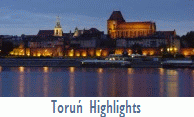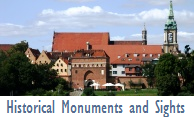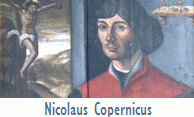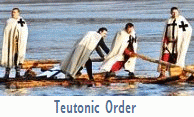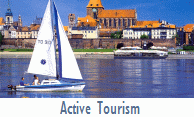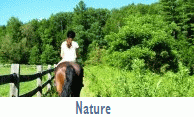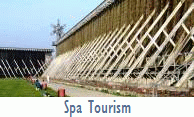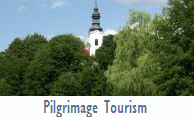|
|
The Kuiavia-Pomeriania region is rich in pure natural areas, especially within the Tuchola Forest, which is a second largest forest after Białowieża Primeval Forest in Poland.
The area of 793,000 acres of beautiful woods and meadows, pure lakes and rivers is filled with silence and soothing air. Although today most of the forest is the effect of pine tree planting, there are still unchanged spots protected as natural reserves (Tuchola Landscape Park, Wda Landscape Park).
The whole complex counts 900 lakes, 40 of which are bigger than 2 acres. The largest ones are: Wda Lake, and Charzykowskie Lake. Two main rivers of the region - the Brda and the Wda rivers join many other lakes and their turns and twists are highly appreciated by canoe lovers.
Visitors will encounter here many forest mammals such as boars, foxes, deer, fallow
|
|
|
| |
|
| |
the Tuchola Forests Map |
| |
Museums |
| |
Hotels in the town of Chojnice |
| |
Landscape Parks |
deer, polecats and badgers, and also birds like herons, white and black storks, wood grouses, eagles and cranes. Nearly 12,000 acres of the most beautiful part of forest make Bory Tucholskie National Park.
|
Tourists come here to experience unprecedented recreational opportunities in one of the most beautiful places in Poland. The river Brda, considered one of the most attractive kayaking routes in Europe, rolls its waters through scenic landscapes. Moments spent on paddling a boat along the river will be remembered and treasured for many days hence.
The district also provides excellent opportunities for cycling in the countryside offering miles of bike tracks to explore, wildlife in abundance, and plenty of sites of interest to visit. Numerous landscape parks and nature reserves are the ultimate ‘green gym’ for all seasons and an ideal facility for those who pursue curriculums of nature literacy, deep ecology and natural history.
|
|
 |
| |
|
|
The area of the present District of Tuchola owes much to the Scandinavian glaciation.
The Scandinavian glacier, the mighty sculptor of the landscape, carved wide valleys, created numerous lakes and deposited large expanses of rolling plains of sediment (a jumble of sand, gravel, mud and detached blocks). Geologic features created by the retreating glacier also include morainic hills, U-shaped valleys and erratic blocks scattered all over the area. This undulating landscape, picturesquely cut by the river Brda, numerous streams and brooks, is dotted with plentiful glacial lakes, including paternoster lakes with ragged shorelines and ribbon lakes with unique animal and plant life. Amidst the forests small tarns and kettle lakes overgrown by peat bog vegetation, and covered by a thick carpet of peat bog mosses offer a stunning view. |
|
 |
| |
|
|
|
The most spectacular parts of the Tuchola Forest have been turned into nature reserves, which preserve the forested areas, particular plant species or peatbogs. The most famous include the forest reserve "Leon Wyczółkowski Old-Polish Yew Trees" in Wierzchlas at Lake Mukrz near Wierzchucin, the landscape reserve "The Source of the River Stążka" and the reserve "The River Brda Valley".
Though the profuse flora and fauna of the past have been dramatically reduced and altered by man, big populations of wild animals can still breed here undisturbed. The Forest, still sparsely populated, provide food and shelter for deer, roe deer, boars, martens, polecats and beavers. The community of birds comprises golden eagles, swans, herons, eagle owls, ospreys, black storks, and kingfishers. Local lakes, streams and rivers are densely inhabited by numerous species of fish, reptiles, and amphibians. The region’s fame sets on stunning woodland and a great surrounding countryside to walk around. Tourists are drawn by the impressive combination of spectacular sights, plenty of wildlife and historic architecture.
|
|

Click on the pictures to read the description (Windows Internet Explorer only)  |
| |
|
|
|
The Tuchola Forest makes an ideal environment for many animals. A profuse variety of habitats guarantees a huge biodiversity of the region. Animals grow and develop in and around numerous lakes and rivers, in vast acres of woodland, on peat bogs, moorlands and meadows. Though much more plentiful and diversified in the past, local fauna is still remarkably diverse. The woods give shelter to numerous birds, insects, reptiles, amphibians and mammals. This land makes a perfect home for many species, which are therefore still abundant: deer, red deer, fallow deer, boar, elk, marten, and otter. Beavers, which have been reintroduced in the region, have built a thriving community. White-tailed eagles, osprays, cranes, swans, herons, eagle owls, black storks and kingfishers still soar over Tuchola and its environs.
|
|
|
Around the Tuchola Forest: Attractive Localities
|
|
Aqueduct in Fojutowo
Aqueduct in Fojutowo (112 km north-west of Toruń, see the map) certainly is one of the most interesting sights of the Tuchola Forest. At the same time it is the longest and the most massive construction of this type in Poland (75 m wide), which refers to the idea of Roman aqueducts. The height difference between the intersecting rivers is approximately 9m. It was built in 1848 with stone and brick. River Czerska Struga flows through the tunnel and above the Brda Canal runs.
................. .................
Monastery in Zamarte
(125 km north-west of Toruń, see the map) Former Bernardine church and monastery of the 18th century. Originally there stood a branch chapel of the parish Niwy founded around 1417, since 1466 owned by the Cistercian nuns from Toruń and Chełmno. In 1746 the Castellan of Gdańsk Jan Grabowski brought Bernardine to Zamarte and built for them the present buildings in 1749. After the dissolution of the order in 1826 the church became a parish. It's belonged to the Discalced Carmelites since 1994.
Interior equipment is extremely rich and ornate. It should be noted that it is also a very homogeneous style, and a whole dates from the foundation of the second half of the 18th century, so we have here some of the altars, pulpit and organ, in typical rococo of white-and-gold colour, and richly carved confessionals and benches decorated with multicoloured intarsia. The murals are of the greatest value and high class, made by one of the Bernardine - brother Paschalis Volos.
 ................. .................
Town of Tuchola
(95 km north-west of Toruń, see the map) Tuchola, town of 14 thousand inhabitants, is a town from which the region name derives. It received town rights in 1346 on the Chełmno law, although the settlement existed as early as in the first half of the 13th century and was taken over by the Teutonic Order in 1308.
After the Order's defeat in the Battle of Grunwald in 1410, a Polish army conquered the town on November 5, 1410. The Order retained the town in the First Treaty of Toruń. At the end of the Thirteen Years' War (1454-1466), however, Tuchola was ceded to Poland in the Second Treaty of Toruń and became part of Polish Royal Prussia. During the First Partition of Poland in 1772, Royal Prussia was annexed by the Kingdom of Prussia.
After the World War I the town was transferred to the Second Polish Republic in 1920.
The Great Fire - an end to the old Tuchola occurred on May 17, 1781 when John Philip Voigt set in fire the church buildings in order to gain the treasures stored there. Thus the town is devoid of any historical monuments.
................. .................
Monastery in Bysławek
(85 km north-west of Toruń, see the map) Monastery complex of the 1st half of the 17th century, remodelled from the Renaissance mansion of the Żaliński family, originally belonged to the Benedictines of Chełmno (Sophia Żalińska when joining the Benedictines in 1602 brought the property as a dowry).
The church with the presbytery built into construction of the monastery (the former manor) Baroque and Rococo furnishing of the 17th and 18th centuries, including image of Christ's birth, probably a copy of the work of Herman Han, an outstanding painter.
................. .................
Kashubian Cottage in Silno
(108 km north-west of Toruń, see the map). The Kashubian cottage in Silno dates back to 1850. It's been opened to the public in June 2001. The exhibition includes equipment of a chamber (living room) with typical residential household furniture, and the other room with different tools and household utensils. It is a branch of History and Ethnography Museum in Chojnice.
|
|
Megalithic stone circles at Odry Reserve
(133 km north-west of Toruń, see the map) Among the rare pine forest, there are located 10 whole and fragments of a few stone circles, of which the smallest is 15m in diametre and the largest is 33m in diametre. On the circumference of the ring the stones are positioned protruding from 20 to 70 cm above the surface of the earth. Their number varies from 16 to 29 pieces in a single ring. One and rarely two stones are set in the middle of the circle. Apart from the circles there are some 30 tumuli with a diametre of 8 to 12 m.
This area is a burial place from the first and second century, and the circles and burial mounds are graves. Inside the mounds there were found: a gold pendant, glass beads, studs, bronze buckle, fabric remnants, fragments of clay pots from the Roman period.
In addition to the urn graves the archaeologists also encountered the presence of traces of two types of funeral rites, which have put forward the thesis that next to the native people which was their custom to burn corpses of the dead, there appeared foreign arrivals from the north.

................. .................
Leon Wyczółkowski Old-Polish Yews Forest Reserve
(85 km north-west of Toruń, see the map; Polish: Cisy Staropolskie im. Leona Wyczółkowskiego) This is the oldest nature reserve in Poland and the second oldest in Europe.
In 1423 Polish king Władysław Jagiełło issued a regulation concerning the protection of yews. Yews have been protected in Wierzchlas since 1827. A note found in 1892 by Hugo Conventz (naturalist from Gdańsk) gives the evidence for that. The note tells the "strict protection" of the "Ziesbuch" Forest in Wierzchlas Forest District, with particular stress put on the protection of yews.
The biggest yew in nature park in Wierzchlas is 600-700 years old. It is 232 cm in circumference (74 cm in diameter), and is 15 m tall.
The Nature Park in Wierzchlas was named in the honor of Leon Wyczółkowski (1852-1936), the eminent Polish painter, who created more than 100 pieces of work there. Wyczółkowski had illustrated the most exciting parts of the reserve, giving the names to them: "Chrobry", "Twin pines", and "Chopin's linden".
................. .................
Town of Chojnice
(118 km north-west of Toruń, see the map) Chojnice, town of about 40 thousand inhabitants, was founded by the Dukes of Pomerania in the 2nd half of the 13th century on the Lübeck law and re-invested in 1360 by the Teutonic Order on the Chełmno law. During the Teutonic reign Chojnice was an important defense point on the route connecting the state of the Teutonic lands with the German Empire. In the years 1417-1436 Chojnice was an important centre for textile production. In 1433 the town was unsuccessfully besieged by the troops of the Polish-Hussite. On 18 September 1454 Polish army of King Kazimierz Jagiellończyk (Casimir Jagiellon) suffered a defeat at the Battle of Chojnice with the Teutonic mercenary army, which resulted in strengthening the resistance of the Teutonic Order and the extension of the Thirteen Years’ War till 1466, (the Second Treaty of Toruń). After the Treaty Chojnice returned with Pomerania to the Kingdom of Poland. Since the mid-17th century, the town experienced a setback due to the numerous invasions, fires, plagues, from which rised in the 2nd half of the 19th century thanks to its position on important routes. During the Nazi occupation in the forest north of Chojnice the Germans carried out a mass execution by shooting about 3 thousands of Poles and Jews.
 What to see in Chojnice: there preserved medieval urban layout of the town with defense walls fragments and 9 towers (out of 24 existing till the 19th century). The Gothic Człuchów Gate (the only gate preserved from the former four) houses the Museum of History and Ethnography.
Gothic parish church of Beheading of St. John the Baptist of the 1st half of the 14th century; the interior has been incinerated at the end of World War II in 1945, thus the tombstone of Jan Gleisen-Doręgowski from the 17th century is the only item of the former furnishing. The other parish church - of the Annunciation, built in 1744 as a Jesuit College church - stands close by. The Baroque church with rich furnishings of the 18th century, ceilings and walls partly covered with polychromy of 1742; the church adjacent to the north building of the former Jesuit College. On the market square Neo-Gothic Town Hall of 1902 with modernist decoration.
|
 Tuchola Forest Museum Tuchola Forest Museum |
|
History and Ethnography Museum |
|
Address:
Tuchola, 3 Podgórna Street, 93 km north-west of Toruń
Opening hours:
High season (July & August): Mon - Fri: 9am - 5pm, Sat - Sun: 10am - 4 pm
Middle season (May & September): Mon - Fri: 9am - 5pm
Low season (October - April): Mon - Fri: 8am - 4pm
Admission fees:
4 PLN, reduced: 2 PLN
Further details: see here
Permanent exhibitions: see here
|
|
Address:
Chojnice, 15 Podmurna Street (119 km north-west of Toruń)
Opening hours:
High season (July & August): Tue - Fri: 10am - 5pm, Sat - Sun: 11am - 4pm
Low season (September - June): Tue & Thu: 10am - 5pm, Wed, Fri, Sat, Sun: 10am - 3pm
Admission fees:
5 PLN, reduced: 3 PLN
Permanent exhibitions:
Prehistory of the Chojnice region,
Kashubian Art,
History of the Town of Chojnice,
Polish Art Gallery,
Albin Makowski Collection
Furher details:
tel./fax: (+48) 52 3974392, 52 397231
|
|
Curent local weather in Toruń  | temp. 7.3° C |
|





